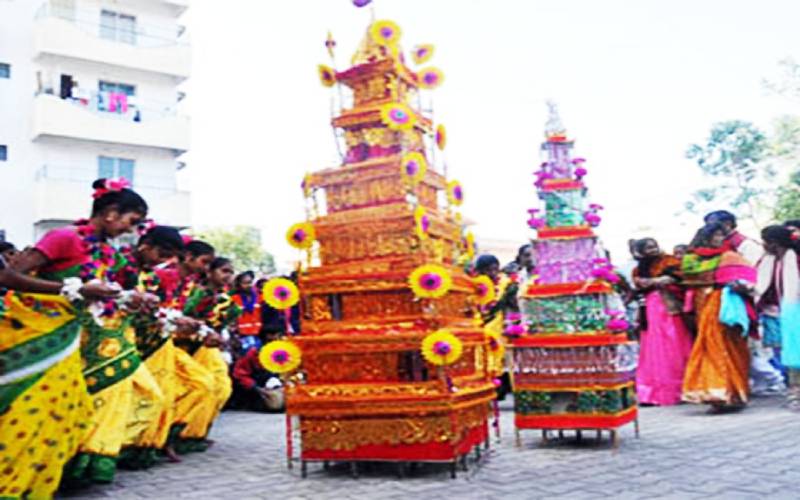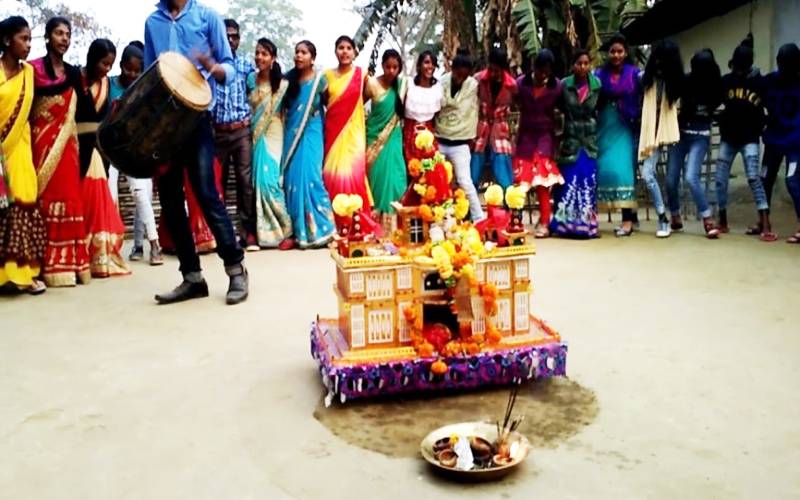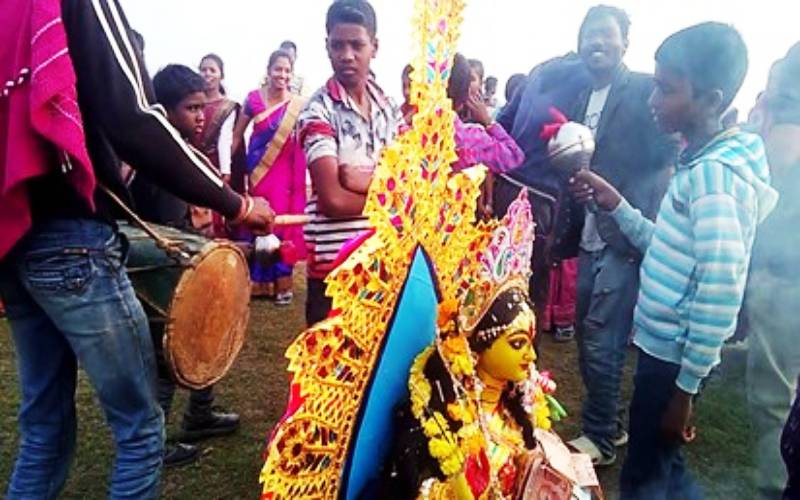Tusu Puja is a Hindu religious festival celebrated in honour of Tusu Devi (Goddess of agriculture) who is believed to be another manifestation of Sakti. In Assam, Tusu Puja coincides with Magh Bihu and is celebrated with much grandeur and fanfare among the socio-economically marginalised vanavasi-s of the tea-garden areas. The very name tusu has been derived from the Bengali word tush, denoting the outer coating of paddy more popularly known as rice bran. It is a derivative from the Sanskrit root usha or osha.
The celebrations of Tusu Puja begin from the first day of the month of Poush in the biting winter cold of December-January (according to the Gregorian calendar) after the harvest of the Amon paddy crop (the winter crop). They continue for almost a month till the last day of Poush, i.e., Paus Sankranti or Makar Sankranti. The young, unmarried girls of the village make beautiful murtis of Tusu Devi which are worshipped on the day of the Parab.

Image of a choudal during Tusu Puja
Tusu Devi is visualised as a chaste, young virgin girl and a cosmic Goddess whose images are drawn on pitchers in the alpana style of painting (Sacred art of colourful motifs done with hand and by using a paste of rice and flour mixed in water). A get-together is organised in the house of a selected person where the girls gather to sing at least one song every night before retiring to sleep. This process continues for 29 days. On the 30th day, women exchange garlands and fry eight varieties of pulses which are given as an offering to Tusu Devi, along with a plate of locally grown rice.
Like Ma Durga, Tusu is also worshipped as a mother, daughter, friend, and confidante to whom the village women can pour their hearts out. In the morning before sunrise, they go to a nearby pond or river to take a ceremonial bath before the commencement of the religious ceremonies. The unmarried girls sing songs and perform various group dances in front of the deity in the evening, seeking her blessings to fulfil their desire for a loving husband. Boys sing to tease the young girls who, in turn, compete to outsmart each other. Dancing also serves as a means of strengthening their social and community bonds on this auspicious occasion.

Community singing and dancing festivities as a part of the Tusu Puja celebrations
Tusu Parab is a festival of socio-religious significance that celebrates femininity and womanhood, acting as a medium of devotional and spiritual expression for both young girls and married women. In Assam, it is a grand socio-cultural and religious celebration among the vanavasi-s of the tea garden areas in Upper Assam, who have a distinct culture of their own. It coincides with Magh Bihu and is thus declared as a regional public holiday every year by the Government of Assam. The rich culture and traditions of the tea garden vanavasi-s is an integral and indispensable part of the overall Assamese culture and heritage, encompassing diverse aspects of its society such as language and literature, way of life, work culture, food habits, politics, society and economy, etc.
At present, there are several lakhs of tea garden labourers in Assam, who have been residing here for about a century and a half. They have accepted this land as their own and contributed in their own wonderful ways towards strengthening the socio-cultural fabric of the state of Assam, and the formation of a greater Assamese identity. Besides Tusu Puja, this conglomeration of people also celebrates Durga Puja, Deepawali, Kali Puja, Manasa Puja, Shivratri, Sarhul, Holi, Karam Puja, Maroi Puja, Sohrai Parab, etc. as per their own traditional customs and belief systems. They also observe Magh Bihu by setting fire to the meji or bhelaghar, besides feasting on popular Assamese delicacies like pitha, chira-doi-gur, etc. Most of their festivals are centred around the womenfolk of their community which also reflects a lot about the history, societal values, and aesthetic lives of the tea garden labourers.
In Assam, there is famous narrative associated with the festival of Tusu Puja. It is believed that Rukmini alias Tusu was one of the beautiful daughters of the Kurmi king of present-day Gujarat. The Sultan of Delhi was, however, desperately trying to annex his kingdom into their dominions through a mass religious conversion of the entire population. Instead of surrendering, the king chose to flee and sought refuge in the court of Birbal, the King of Punjab. It was during those days that Tusu and Sitaram, the son of Birbal, fell in love with each other. But the Sultan now wanted to own Tusu. He was baying for the blood of Tusu’s father, the Kurmi king. This became a factor of obstruction in Tusu and Sitaram’s relationship.
The king eventually had to leave in order to escape the wrath of the enemy. Tusu and Sitaram too, accompanied him and ran away from Punjab first to the land of the Santhal-s, from where they reached the deep and dense jungles of Assam. It was here in Assam that the Chawtal and Bhumij vanavasi-s residing in the Valley of the Brahmaputra came to know about Tusu and Sitaram’s relationship and helped the lovebirds get married under the initiative of the Bhumij king. But, in a quite unfortunate turn of events, Tusu’s husband died within just a few days of their marriage. Meanwhile, news poured in that the soldiers of the Sultan of Delhi were leaving no stone unturned to capture Tusu.
Unable to bear the tragic loss of her husband and also to save her soul from becoming a slave in the hands of the invader, a distraught Tusu self-immolated herself. She willingly sat atop the funeral pyre of her husband, thus becoming sati and soon transforming herself into a living shakti. It was from then onwards that the Kurmi-s, Chawtal-s, and Bhumij-s of Assam began to worship Tusu as a pure soul. With the gradual passage of time, she came to be worshipped as Ma Sita and Ma Savitri. It is believed that through sheer devotion, Savitri had managed to bring back to life her dead husband from the kingdom of Yamaraj.
Many of the vanavasi communities also compare Tusu with Ma Kali and Ma Durga. She is venerated among other things, with different songs that are a vivid description of the various aspects of her life. Sculptors carve beautiful murtis of Tusu Devi on the occasion which are decorated by people with mud and fresh flowers on the first day of the festival called Uruka. Young boys and girls carry the murti from house-to-house singing the praises of her glory and unmatched love and dedication towards her husband. Many a times, the murti is placed at a common place of worship, such as an open field or playground, where the locals offer their prayers throughout the day.

Tusu Puja at Borbil, Tinsukia district of Upper Assam
It is an extremely pleasing sight to see the young girls of the community elegantly decked up in their traditional finery and dancing Jhumur to the tunes of the madal, with waving handkerchiefs in their hands. It is a cheerful gathering of young people who at the end of the festival, collectively arrange a public lunch or dinner with the money received as a token of blessing from the visited households. Tusu Devi symbolises the virtues of kindness, love and sacrifice and happens to be the favourite Goddess of the tea garden vanavasi-s of Assam.
Tree plantation drives and book-release functions are organised in several places of Upper Assam as a mark of the occasion. Different competitions such as drawing competitions, dance and song competitions, and essay writing competitions, etc. are organised among students on this day. Just like in other parts of India, both Til (Sesame seeds) and Gur (Jaggery) are the two most important ingredients of the various traditional dishes that are prepared on the occasion of Tusu Puja in Assam, also known as Til Sankranti. At the end of the ceremonies, the murti of Tusu Ma is immersed in the flowing waters of the Brahmaputra. There is a traditional custom in which many devotees forge new bonds of friendship on this day, with the river as a witness to their promise.
It may be recalled here that the discovery of tea in Assam during the mid-19th century had resulted in populating the state with people from different vanavasi communities such as Ho, Kol, Chawra, Santhal, Munda, Chaotal, Oraon, Kharia, Khond, Gond, Guwal, Karmakar, Malpaharia, Tanti, Tasa, etc. They were largely brought through deceit by the agents of the British sahibs from the present-day Chhotanagpur plateau region of Central India, Odisha, Andhra Pradesh, etc., to work as labourers at a very low wage in the large British-owned tea estates. Their life was hard, and many died of disease and criminal neglect.
Factors such as the interior locations of the tea gardens and extremely limited interactions with the outside world, language barriers, and dissimilarity in physical appearances, etc., were some of the primary factors which made them an insulated-lot from the rest of the population in Assam. But they have embraced Assam as their homeland since a long time back, and beautifully assimilated themselves with the Assamese culture and traditions. Today, Christianity is emerging as a popular religion among these vanavasi-s, chiefly facilitated by the spread of missionary-led English-medium schools.
Tusu Puja was earlier celebrated for the entire month of Paus. But, in the recent years, due to the constraints of time and changing circumstances, the celebrations have been reduced to only two days of the month, i.e., the previous day of Paus Sankranti (The 29th day of Paus) which is observed as Jagoron (Awakening), and the next day on which the festivities formally come to an end. With the changing times and the influence of various external factors, a traditional village-centric festival like Tusu Puja is also changing its trends. Commercialization has crept in, and competitions have taken precedence over the religious rites and rituals of worship in many places. Memories of Tusu Geets (Songs) are today getting replaced by Bollywood songs and DJ dance numbers.
Earlier, Tusu Puja was celebrated mainly as a household affair. However, nowadays, elaborate Choudal-s (A lightweight cylindrical structure resembling the vimana of a temple, hand-crafted from wood, bamboo, hay, and jute sticks with bits of coloured paper and other decorative items stuck to it) are especially prepared for taking part in the competitions, in which winners receive cash prizes. It is mainly because of these competitions that the choudal-s have become bigger and brighter, attracting large crowds of people at the melas. Winning these competitions has become a matter of great prestige among the choudal makers. Photographers eager to click pictures of the young girls in different poses are quite a common sight in the tea garden areas of Chabua and Makum in Upper Assam on the occasion of Tusu Puja.
 The author is a PhD, Researcher on the Sanatan Hindu past of Poorvottar Bharat, Writer & Columnist.
The author is a PhD, Researcher on the Sanatan Hindu past of Poorvottar Bharat, Writer & Columnist.
NEXT ARTICLE

At the southernmost tip of this mesmerising ensemble lies the majestic Great Nicobar Island, boasting an impressive landmass of about 910 square kilom...

Bharath has always been a land traversed by spiritual masters/ Guru since time immemorial. These spiritual masters have always upheld the core princip...

South India contains its fair share of unique pilgrimage centres. These divine places of worship have a prominent Sthala Purana, devoted followers, di...